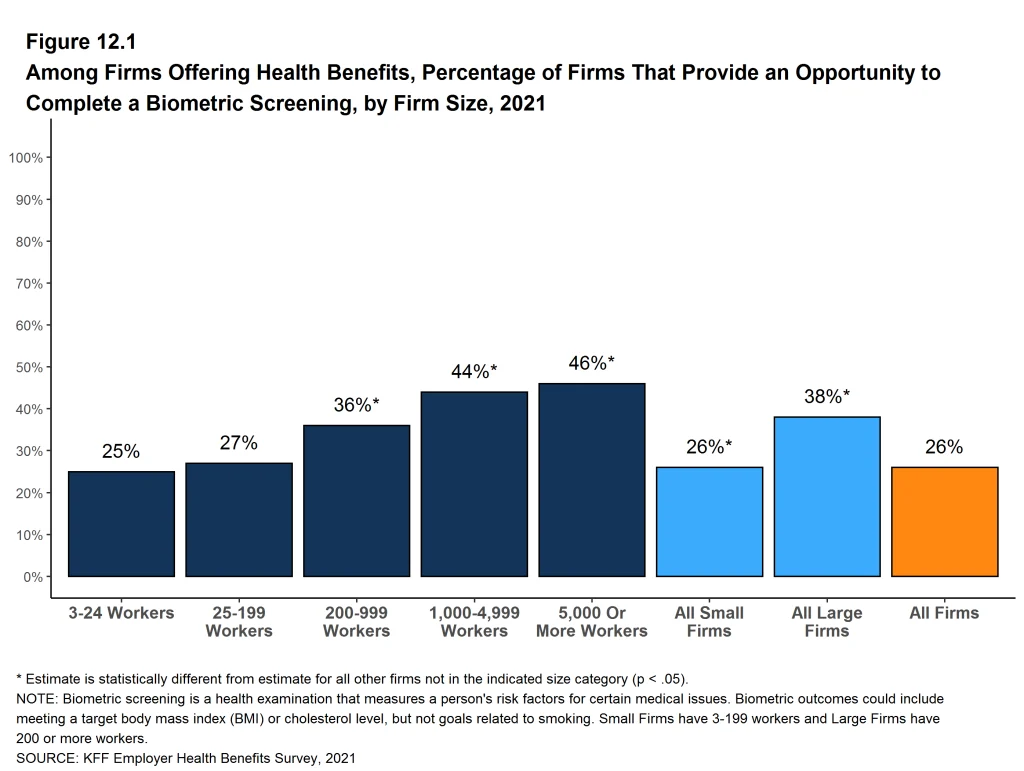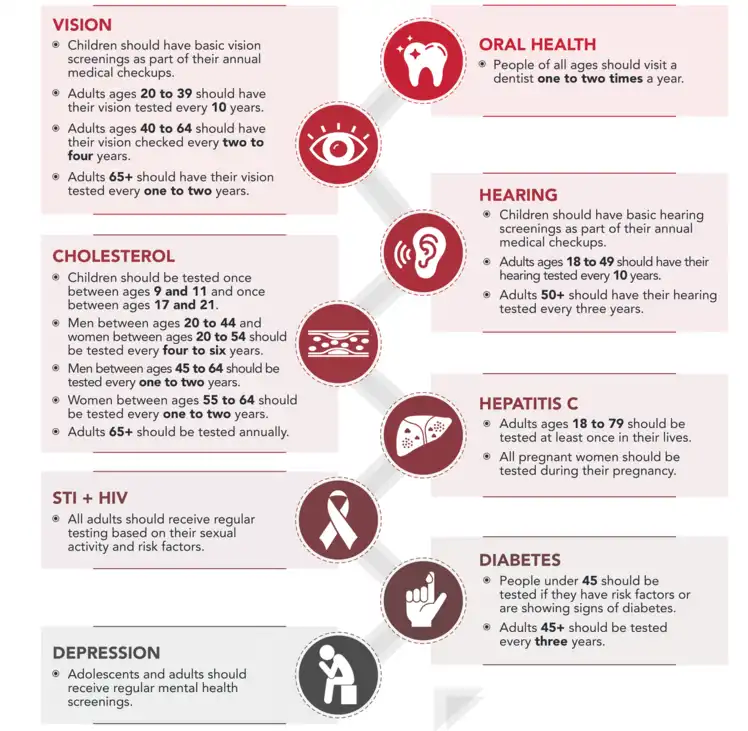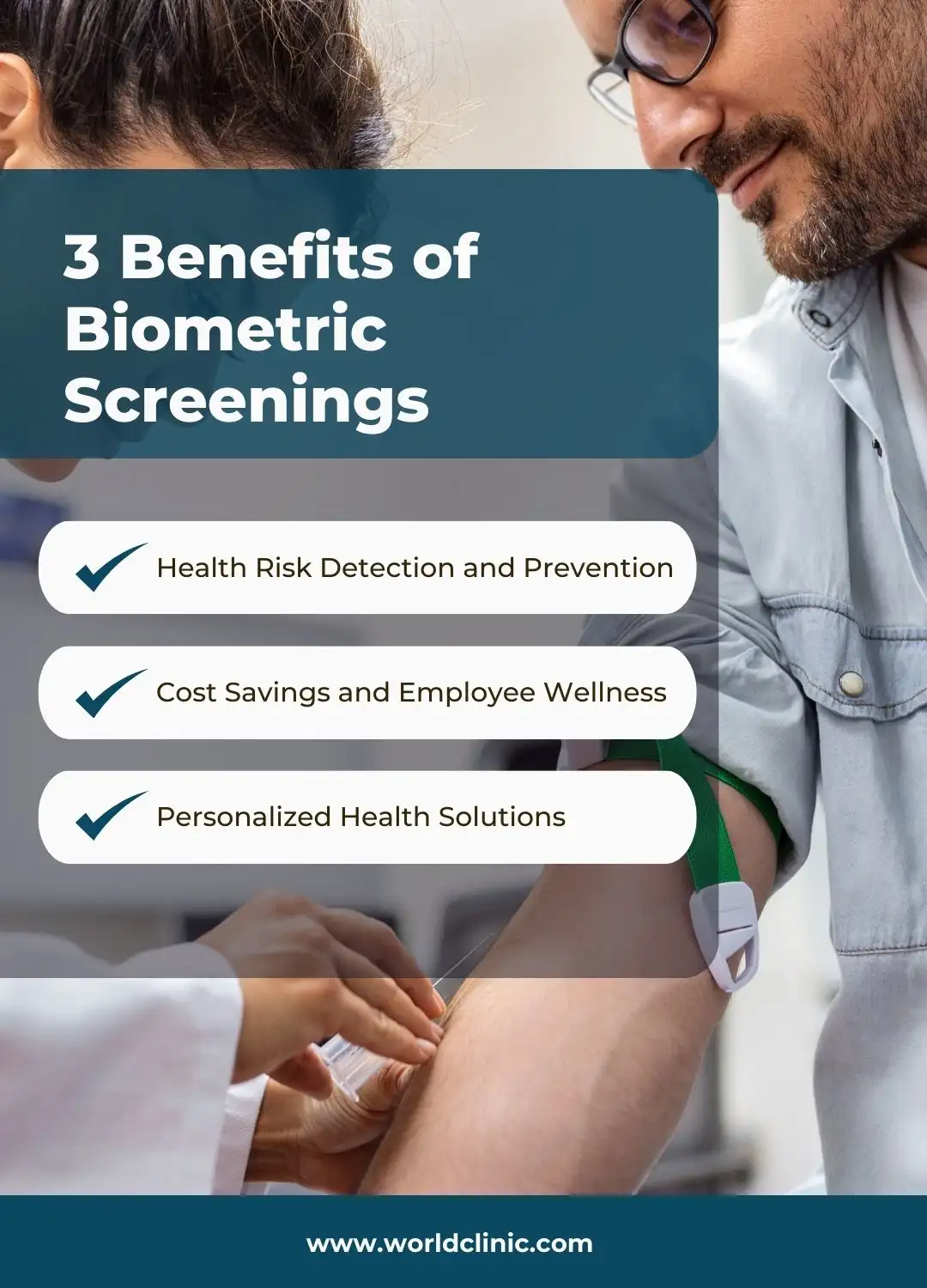Today, it’s widely known that precision and personalization define the quality and effectiveness of care. Understanding our bodies in concrete, measurable ways can be fundamentally transformative. But what doesn’t get discussed nearly enough is just how pivotal biometric screenings are as a mechanism to achieve this.
Each metric captured during biometric health screening tells a story. A story that, when pieced together, offers a clear picture of where someone stands health-wise and, more importantly, where they might be heading.
Particularly for those whose health carries a weight of responsibility—executives, business owners, and anyone charged with leading others—the significance of understanding one’s health cannot be minimized.In this blog, we’ll get into the many aspects of what really makes these assessments worth paying attention to and prioritizing.
What is Biometric Screening?
Biometric screening is a structured evaluation of vital health markers, designed to provide detailed insight into a person’s physical condition. It typically includes measurements like blood pressure, cholesterol levels, blood glucose, and body mass index (BMI), gathered through quick, non-invasive tests. Each measurement reflects a critical area of overall well-being, creating a clear picture of where a person stands in terms of their physical health and when done regularly, is able to detect patterns or signs indicative of emerging health issues.
What’s the Purpose of Biometric Health Screening?
Biometric screening is, essentially, a health risk assessment. It’s designed to bring underlying issues to the surface—whether it’s a creeping rise in blood pressure or an unnoticed spike in cholesterol. By recognizing these markers early, healthcare providers can intervene before those subtle shifts become critical problems. The data not only aids in diagnosis but actively drives preventive care, ensuring that minor health concerns are addressed swiftly rather than after the fact.
In the corporate world, they have become a keystone of wellness programs. Employers recognize that the health of their workforce directly impacts productivity, and these screenings offer a proactive means of keeping teams healthy. They provide a structured way to identify those who may benefit from further medical attention, guiding them toward appropriate care before more intensive interventions are necessary.
Moreover, they facilitate care coordination efforts, ensuring that individual health is monitored with a continuity that aligns with long-term well-being goals.

What Does Biometric Screening Include?
The scope of screenings can vary depending on the specific goals, but here are 3 key focus areas that make up most screenings:
1. Blood Tests
Blood tests provide data on fundamental metabolic and cardiovascular functions. Typically, these tests focus on key markers like cholesterol and glucose levels.
1.1 Cholesterol
Cholesterol, often misunderstood as a single entity, unfolds into multiple subtypes that each tell a different story about heart disease risk.
Lipid profiles, including HDL (the “good” cholesterol), LDL (the “bad” cholesterol), and triglycerides, are carefully measured to gauge the condition of your cardiovascular system.
HDL works to clear cholesterol from the bloodstream, while elevated LDL or triglycerides suggest a higher likelihood of arterial plaque buildup and blockages, which can lead to heart attacks or strokes.
1.2 Glucose
Glucose readings tell a similarly pivotal story. What you see in glucose is the story of how the body processes energy and manages cellular demand. Persistently elevated fasting glucose levels often give the first indications of insulin resistance, prediabetes, or the early stages of type 2 diabetes.
2. Weight Measurement and Body Composition Analysis
Weight alone is a crude measure—it lacks the precision necessary to decode what’s really happening within. Body composition analysis, however, digs deeper. BMI gives a rough estimate, but what truly matters is the distribution of fat, particularly visceral fat—the insidious kind that wraps around vital organs and drives metabolic dysfunction from the inside out. Visceral fat doesn’t simply sit there—it actively disrupts, triggering inflammatory responses, insulin resistance, and an increased risk of cardiovascular disease.
Through comprehensive body composition analysis, we can dissect whether the pounds gained reflect muscle mass or fat accumulation, and more importantly, whether this excess weight is laying the groundwork for conditions like hypertension, type 2 diabetes, or even certain cancers.
3. Blood Pressure Checks
Blood pressure—an often-underestimated metric—reveals far more than people realize. It’s not necessarily just about how hard your heart is working; it’s about the cumulative strain being placed on your arteries, organs, and entire cardiovascular system. High blood pressure, or hypertension, is a well-known risk factor. This is because, over time, it can damage your arteries, making them less flexible and increasing the risk of heart attack, stroke, and kidney problems.
4. Additional Tests Based on Risk Factors
Depending on individual health profiles or specific employer-driven wellness programs, additional testing is sometimes recommended/required.
How is Biometric Screening Done?
The process is quick, and the experience is more structured than invasive, following a clear sequence of steps.
1. Physical Measurements
The screening typically starts with basic physical measurements. A healthcare professional will measure your height and weight, after which, BMI is calculated. This gives a basic assessment of whether an individual’s weight is appropriate for their height, although, as mentioned earlier, BMI alone is not a comprehensive health indicator.
Next, body composition analysis may be conducted using specialized equipment to provide a more granular view of the ratio between fat and muscle and can help reveal patterns that BMI alone cannot.
2. Blood Pressure Measurement
Using a blood pressure cuff, the systolic (pressure during heartbeats) and diastolic (pressure between beats) numbers are recorded. These results indicate how hard the heart is working and whether arteries are becoming resistant to blood flow.
3. Blood Draws
A small sample of blood is taken, either from a finger prick or, in some cases, a venous blood drawn from the arm, and sent for lab analysis. This sample is used for testing the cholesterol levels, blood glucose, and other key markers.
4. Optional Additional Testing
Depending on the individual’s risk profile or the requirements of their employer, additional tests might be included. Additionally, some screenings may also include a brief review of lifestyle factors such as diet, exercise habits, and smoking status. These will help pinpoint areas of improvement or where possible issues may stem from.
5. Wrap-Up and Review
Once all the measurements and tests are completed, the healthcare provider may offer a brief review of the results if available onsite. More often, however, the data is sent to a lab, with results delivered back to the patient and their physician within days. From there, the data can be translated into action, whether it’s refining a wellness plan or coordinating further medical evaluation.

How are the Results Used?
Healthcare providers use this integrated information to identify specific areas that require attention, allowing them to create personalized health plans tailored to the individual’s unique needs and goals. This customized approach ensures that interventions are precise strategies designed to optimize health outcomes rather than broad, generalized recommendations.
Establishing this baseline also enables effective tracking of progress over time. As individuals engage with their personalized plans, subsequent screenings can measure improvements or bring new concerns to light. This allows for continuous adjustments to care strategies, ensuring they remain aligned with the patient’s evolving health status. In cases where results highlight significant risks, providers can promptly coordinate follow-up care, involving specialists or additional resources as necessary.
Biometric Screening vs. Physicals: What’s the Difference?
While annual biometric screenings and annual physicals are often mentioned in the same breath, they serve distinctly different purposes and operate on separate levels of depth and focus. The distinction lies in both the scope and the intent behind each.
Biometric Screenings
Biometric screenings are, by design, targeted and data driven. Their focus is to gather measurable, objective health indicators quickly and efficiently. They look at specific metrics that are most predictive of future health risks, ideally before symptoms appear, and provide a foundation for the benefits of preventive health.
These screenings are streamlined, often taking place in workplace settings or as part of a corporate wellness initiative. They provide a snapshot—albeit a detailed one—of certain health markers at a given point in time and are excellent for monitoring trends over months or years. However, they generally stop short of the comprehensive, exploratory nature of an annual physical.
Physicals
A physical, including executive physicals, on the other hand, is a more comprehensive assessment of overall health. It goes beyond data collection. Physicians use this time to delve deeper, addressing both quantitative metrics and qualitative aspects of a person’s well-being. During a physical, the doctor conducts a hands-on examination, assessing the body through palpation, listening to the heart and lungs, checking reflexes, and performing other assessments that biometric screenings simply don’t cover.
The annual physical is an opportunity to discuss lifestyle factors, mental health, and other variables that might not show up in a blood test but are nonetheless integral to one’s health. It’s an ongoing dialogue between patient and physician, allowing for adjustments in medication, treatment plans, or health strategies. It’s proactive, but in a broader, even more personalized way.
3 Benefits of Biometric Screenings

There are several benefits to undergoing biometric screenings, both for the individual and the organization at large.
1. Health Risk Detection and Prevention
These assessments offer something irreplaceable—early insight. Small, unassuming changes in blood pressure or cholesterol may seem inconsequential, but they often mark the beginning of a health decline that could take years to surface fully. Through biometric health data, these shifts can be addressed before they spiral into major health issues. For employers, employee health screenings mean fewer surprises, fewer heart attacks, and fewer emergency interventions.
2. Cost Savings and Employee Wellness
The impact of poor health is not just seen in rising insurance premiums or medical claims. It’s felt in every day missed, every task left incomplete, every ounce of productivity lost. A workforce that’s consistently healthy is more stable, more productive, and less costly to manage. Long-term, this translates into tangible improvements in everything from output to company culture.
3. Personalized Health Solutions
With data specific to each employee, companies can target wellness interventions more effectively. For example, employees with high cholesterol receive guidance relevant to heart health, while those with elevated glucose levels can be directed toward prediabetes programs. The result is not just a program on paper, but one that resonates with employees because it speaks directly to their individual health concerns, motivating real change.
4 Challenges and Considerations
Of course, historically, there have been a few challenges in implementing them and using them effectively. However, we have taken these into consideration and developed improved processes.
1. Accessibility
For many, keeping up with regular health tests can quickly become a logistical burden. Whether it’s busy professionals with limited time or frequent travelers constantly on the move, staying consistent with healthcare appointments often slips through the cracks. The challenge here isn’t just availability; it’s accessibility—ensuring screenings are conducted when and where they are needed without disrupting the patient’s life.
1.1 WorldClinic’s Solution:
WorldClinic addresses this by coordinating local, convenient options for biometric screenings, ensuring patients have access to trusted providers no matter where they are. Rather than waiting for a patient to return home or find time in their schedule, we help arrange screenings at locations that fit seamlessly into their daily lives.
2. Data Privacy
With cyber threats ever-evolving, the fear of sensitive medical information being compromised is very real. Patients want and deserve to know that their personal health information is protected.
2.1 WorldClinic’s Solution:
We employ advanced security protocols, including HIPAA-compliant telemedicine platforms, to ensure data integrity. Secure summarized electronic medical records (EMRs) provide the necessary information without exposing unnecessary details, minimizing the risks tied to data breaches.
3. Reliability
Accuracy varies depending on the provider, the equipment used, and the rigor of the testing protocols. For patients, this variability means that some may receive incomplete or inaccurate results, leading to misguided health decisions.
3.1. WorldClinic’s Solution:
By partnering with trusted providers and combining the results with insights from board-certified physicians who know their patients well, WorldClinic ensures that the data isn’t just accurate but relevant to the individual. Our doctors, familiar with each patient’s health history, can interpret the results in the context of the individual’s needs and, when necessary, provide expert referrals to specialists who can take it from there.
4. Continuity of Care
One of the biggest challenges is what comes next. Patients often receive their results but don’t follow through with the necessary steps for ongoing care. Whether it’s due to the complexity of the information, a lack of clear guidance, or just the day-to-day distractions of life, critical follow-up gets lost.
4.1 WorldClinic’s Solution:
Our doctors don’t leave patients at a crossroads once the data comes in. With physician-led health coaching, longevity planning, and end-to-end care coordination, we ensure that every screening result leads to a clear path forward. Facilitated referrals, ongoing monitoring, and personal
Conclusion
As we can now see, when we go beyond looking at biometric screening as a mere series of tests, we can begin to recognize their true intended value. Data is just data on its own, but when we pair it with a deliberate, personalized, expert-driven approach, it transforms into something with far greater potential. The numbers become narratives—revealing patterns, predicting future health risks, and guiding informed decisions.
We have built our model around that very philosophy—seamless care that doesn’t stop at data collection but forms the starting point for ongoing, personalized, precision-driven care.
For those who are serious about taking control of their health or organizations serious about keeping their leadership team in top form, our concierge medical services provide the support needed to keep health in focus, no matter the demands. Let’s make this the start of something lasting. View our Concierge membership plans or feel free to contact us anytime to find out more.
Biometric Screening FAQs
Is biometric screening voluntary?
Yes, biometric health screening is typically voluntary. However, some employers may offer incentives to encourage participation, but it is ultimately an individual’s choice to take part.
Is biometric screening worth it?
For many, biometric screenings serve as an invaluable tool in identifying early risk factors for health conditions, helping to prevent future complications.
Are biometric screening results available to the employer?
Employers generally receive aggregated, anonymized data from screenings. This helps them understand health trends across the workforce, but individual results are confidential and are not shared without explicit consent.
What are the cons of biometric screening?
Some people may feel uncomfortable with the invasive nature of the tests, and false positives can lead to unnecessary stress or follow-up procedures. Also, there can be concerns about privacy despite the anonymity of data.
How long does a biometric screening last?
The actual screening process is usually quick, often lasting about 15-30 minutes, depending on the tests being done.
How to prepare employees for a biometric health screening?
Employees should be informed about the purpose of the screening, what to expect, and how the results will be used.
Does a biometric screening test for drugs?
No, generally they do not include drug testing. They typically focus on health markers such as blood pressure, glucose levels, cholesterol, and BMI.
Are biometric screenings free?
Many employers offer biometric screenings as part of wellness programs, making them free for employees. However, this can vary depending on the employer and the healthcare plan in place.


